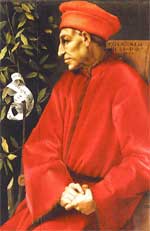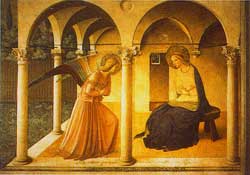Cosimo de' Medici
The private life of Cosimo de' Medici, who became virtually head of the Republic in 1434, was simple and unostentatious. The kindest of fathers, and the friendliest of fellow-citizens, he was before everything a merchant, but a merchant on the grand scale, with a large outlook and far-reaching views. Moreover, all the culture of the times was represented in him.

Cosimo de' Medici,
Pater Patriae
Cosimo de' Medici had an alert mind and an admirable judgment, together with a real appreciation of beauty. He was quick to recognize merit; poets, philosophers, artists were his natural friends but critics, copyists, teachers, translators, were all recognized and rewarded by him.
Of all the arts, architecture seems to have appealed to Cosimo de' Medici the most, and it was to buildings that he looked for immortality. He often said that he knew the nature of the people, and that in fifty years nothing would remain of him or of his house except the few buildings that he had erected. Among these we may name the Medici (now Medici Riccardi) Palace, San Lorenzo, the Badia at Fiesole, and his villas at Careggi and Cafaggiuolo.
The Convent of San Marco and the Platonic Academy
Cosimo de' Medici's greatest gift to Florence was undoubtedly the Convent of San Marco built for the Dominicans. About it, Vasari says that "it is the best conceived and the most beautiful and most convenient of any in Italy." Michelozzo was the architect, and the cost was 36000 florins. Cosimo endowed it with a magnificent library; he also laid out the garden, causing it to be admirably stocked,as horticulture and farming were among his hobbies.
Cosimo de' Medici loved San Marco; he kept a cell there for himself to which he often retired, spending much time in conversation with the Archbishop Antoninus, and with Fra Angelico, who was then adorning the Convent with his spiritual masterpieces.
Cosimo de' Medici had no taste for pleasure and amusements (unlike his illustrious grandson, Lorenzo), and no appreciation of a jest, although a number of cynical sayings of his give evidence that he had a certain caustic wit. Ordinarily he was grave and silent, diligent, and, in his latter years, immensely occupied with religion. Cosimo was no less at home with men of letters than with artists and his second gift to Florence, the Platonic Academy, might almost be said to rival the first in its far-reaching effects.
Cosimo de' Medici founded the Academy following the visit of Gemistos Plethon to Florence in 1439, a man over eighty years of age, but full of vigor and enthusiasm. He was the most learned of the Greeks, and his writing was so that it was impossible to distinguish it from that of the best classical time. He was steeped in eastern mysticism, and really knew more of Zoroaster and Pythagoras than of Plato, for whom he had the most profound reverence. He despised western scholasticism, and regarded the Latins as barbarians.

Fra Angelico
Annunciation, 1449
Fresco, San Marco, Florence
Gemistos inaugurated the dispute between the rival systems of Plato and Aristotle. He inspired Cosimo de' Medici with such zeal for philosophy as it resulted in the foundation of the Platonic Academy, and the Florentines' minds were turned to a branch of study hitherto neglected by them.
Cosimo de' Medici requested that Gemistos writes a treatise on the subject of the rival systems of Plato and Aristotle, which ended emphasizing the superiority of the former. The resulting discussions roused a perfect storm of contention and invective, which Bessarion, the Latin Patriarch of Constantinople, eventually succeeded in calming down, leaving Plato victor in the fray. Gemistos, who was occupied with the idea of founding a mystic religion of his own, did not wait for the termination of the controversy, but returned to Mistra, where he established his religion with its own liturgy; he died in extreme old age. His name was always revered in Italy, and in 1465, when Sigismundo Malatesta captured Mistra, he brought back the ashes of Gemistos to Rimini to be placed in a sarcophagus outside the church of San Francesco, which Alberti had just built.
Cosimo de' Medici's initiative led to religion, art and literature taking a peculiar color from the Neo-Platonic ideas, and their influence was felt through all succeeding centuries.
With that eye for the right man which always distinguished him, Cosimo de' Medici singled out Marsilio Ficino, the son of a physician and himself a doctor, as the future president of his foundation, telling the father that his son was born to minister to minds, not bodies. Ficino therefore devoted himself to the study of Platonic ideas, began to make a translation of Plato into Latin, and subsequently translated Plotinus, Proclus and Porphyry. The activities of the Academy belong rather to the days of his grandson, Lorenzo, than to those of Cosimo de' Medici, though Cosimo was consoled on his death bed by listening to Ficino's rendering of Plato's Philebus.
Cosimo de' Medici, Pater Patriae (to give him the noble title which his fellow citizens unanimously bestowed upon him), lies beneath a plain slab of marble before the high altar of San Lorenzo, thus preserving in death the simplicity he had loved in life.